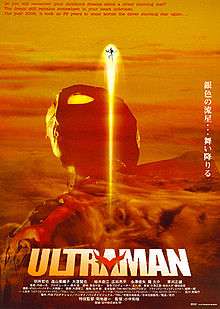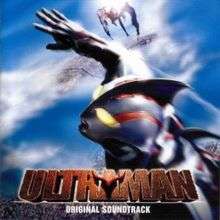Ultraman: The Next
| Ultraman: The Next | |
|---|---|
 Theatrical Poster | |
| Directed by | Kazuya Konaka |
| Produced by | Kiyoshi Suzuki |
| Written by | Keiichi Hasegawa |
| Starring |
Tetsuya Bessho Kyoko Toyama Nae Yuuki |
| Music by | Tak Matsumoto |
| Distributed by | Shochiku |
Release dates |
|
Running time | 97 minutes |
| Country | Japan |
| Language | Japanese |
Ultraman: The Next, released in Japan simply as ULTRAMAN (ウルトラマン Urutoraman), is a 2004 Japanese science fiction tokusatsu film directed by Kazuya Konaka and produced by Tsuburaya Productions. A reimagining of the Ultraman character and franchise, the film was part of the "Ultra N Project", a three-phase experiment aimed to reinvent the franchise for an older audience.[1]
Ultraman: The Next was released in Japan on December 4, 2004 but had its premiere at Grauman's Egyptian Theatre in Hollywood on June 25, 2005.[2]
Ultra N Project
Tsuburaya Productions started the "Ultra N Project" in 2004, in an attempt to revitalize the Ultra franchise. The project consisted of a press conference unveiling of Ultraman Noa, the airing of the new Ultra Series Ultraman Nexus, and this movie featuring Ultraman Next. Ultraman Next resembled a lifelike insectoid version of Nexus (with insect-like body armor and organic tissue-like skin underneath). This was the first Ultraman ever to possess this sort of characteristic, a departure from the traditional "clean and shiny" look. BEING GIZA artists provided the theme songs for ULTRAMAN and Ultraman Nexus.
Plot
First Lieutenant Shunichi Maki of the Japan Air Self-Defense Force is a prestigious F-15 Eagle jet pilot. A lifelong fan of flying since he was a child, being a pilot is his ultimate dream. Unfortunately, his duties distance himself from his wife, Yoko, who feels neglected, and his son, Tsugumu, who has a possibly terminal congenital blood disease.
Maki decides to quit the Air Force to devote more time to his family and to spend whatever time is left with his son. He takes a part-time job as a commercial tour guide for a kindly group of people who allow him time to take care of his family.
Prior to quitting, Maki and his flight partner Yamashima are alerted to a strange red light streaking towards Japan, and Maki's plane passes through the red light seemingly without any damage. He suffers no ill effects other than strange images briefly playing out in his mind. He later discovers that the images are telepathic messages from a strange being that exists in the red light.
Production
Design
Veteran Ultraman designer Hiroshi Maruyama stressed the difficulty of reinventing the Ultraman design, stating, "Ultraman is a very simple design. This, unfortunately, removes some of the simplicity which is a big part of the design’s charm. But it really can’t be helped. If you tried to remove anything form that design what would you have? It would look like Pepsi Man!" Maruyama originally wanted to give Ultraman "transparent skin" with "glowing streams of red energy" but stated that the executives found the idea "a bit too shocking".[2]
From Next to Nexus and Beyond
The movie ULTRAMAN was released in theaters about one third of the way into the televised run of Ultraman Nexus, and acts as background for the series. Ultraman Nexus is set five years after the events of ULTRAMAN, in the year 2009, with Himeya Jun (Junis Red), Senjyu Ren (Junis Blue), and Komon Kazuki (Noa) taking charge as Maki's successors. Sara also returns near the series finale, serving as an advisor to TLT and Night Raider during the final attack.
The events in this movie are referred to as 'A.D. 2004' in the Ultraman Nexus series. In addition, the TLT collaborates with an unknown alien force to erase any memory about the incident in the entire human race, in order to 'protect those who experienced trauma' after the violent events in ULTRAMAN. They also cite the cause of extreme damage in the city of Tokyo due to a "violent meteor shower".
When Ultraman Nexus ended, the exact place of Ultraman Next/Nexus/Noa in the wider Ultraman continuity was unclear. No explicit references to the Ultra Garrison or any other Ultra characters were ever made. Three monsters from Ultraman Nexus (Banpira, Frogos and Galberos) appeared in the series Ultra Galaxy Mega Monster Battle (2007) and its sequel Ultra Galaxy Mega Monster Battle: Never Ending Odyssey (2008), and the same three monsters appeared in the Monster Graveyard in Mega Monster Battle: Ultra Galaxy (2009). Rather than this having any plot significance, these appearances probably had to do more with the costumes being relatively recent and therefore still in good enough condition to be used onscreen. The 2010 movie Ultraman Zero: The Revenge of Belial finally revealed that Ultraman Noa and related characters existed in another universe, one that usually had no interaction with the "M78" universe of the early Ultraman series. Ultraman Zero travels to this other universe to find Kaiser Belial and eventually merges with the power of Ultraman Noa.
Cast
Main characters
- Shunichi Maki (真木 舜一) / Ultraman the Next (ウルトラマン・ザ・ネクスト): Played by Tetsuya Bessho.
- Sara Mizuhara (水原 沙羅): Played by Kyoko Toyama (遠山 景織子).
- Takafumi Udou (有働 貴文) / Beast the One (ビースト・ザ・ワン): Played by Kenya Oosumi (大澄 賢也).
Supporting
- Nae Yuuki (裕木 奈江)
- Ryouhei Hirota (広田 亮平)
- Toshiya Nagasawa (永澤 俊矢)
- Daisuke Ryu (隆 大介)
- Masao Kusakari
Original soundtrack
| Ultraman Original Soundtrack | |
|---|---|
 | |
| Soundtrack album by Tak Matsumoto | |
| Released | July 20, 2005 |
| Recorded | Birdman West, Rodeo Recording, Giza Hills Studio, Green Way Studio, Cock and Bottle Studio |
| Genre | Hard rock |
| Length | 56:29 |
| Label | Vermillion Records |
| Producer | Tak Matsumoto, Sussie Tamagawa, Hiroshi Suzuki, Ryo Watabe |
The original soundtrack was produced by Tak Matsumoto (of B'z), under his Vermillion Records label (which is in turn, a part of the Being Giza group). It was released in Japan on July 20, 2005. The catalogue code for the album is BMCV-8015.
Theme songs
- OP: "Theme from ULTRAMAN" by Tak Matsumoto
- ED: "Never Good-bye" by TMG
References
- ↑ Ballard, James. "Tsuburaya Productions, 2004: A Year In Retrospect". Scifi Japan. Retrieved May 18, 2015.
- 1 2 "Ultraman: The Next (PRESS NOTES)". Scifi Japan. May 15, 2010. Retrieved May 18, 2015.